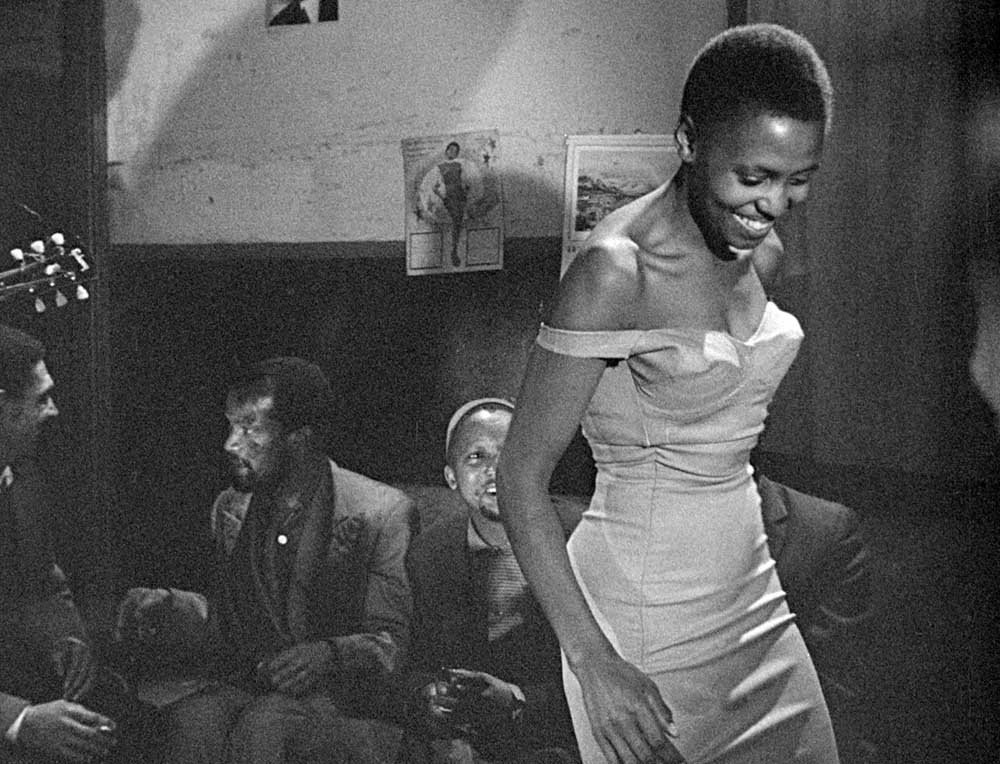
"The miracle of Lionel Rogosin's apartheid drama Come Back, Africa isn't that it's a solid, affecting artifact of a cruel society, but that it exists at all," begins Bill Weber in Slant. "In the wake of his debut film, the New York skid-row chronicle On the Bowery, Rogosin set out in 1957 for Johannesburg, and for months laid the groundwork for surreptitiously shooting a follow-up that would lay bare the pain and humiliations of black South Africans subjugated by the white majority, enlisting native writers Lewis Nkosi and Bloke Modisane to collaborate on the scenario. Mixing documentary-like footage with scripted scenes as he had in his first feature, the filmmaker heavily features music and dance by throngs of street performers, a diegetically captured salve for the wounds of extreme poverty and social oppression — and an ideal camouflage of his critical agenda from the South African authorities, who were persuaded that he was assembling a musical or a travelogue."
"Rogosin structures his story around Zacharia (Zacharia Mgabi, whom the director found in a bus line)," writes Melissa Anderson for Artforum. "A refugee in tattered shirts and blazers from the famine-stricken KwaZulu homeland in the nation's southeast, Zacharia comes to Johannesburg in desperate search of a job. Without a work permit, he is unable to secure employment in the gold mines; he is quickly dismissed by racist employers (or bosses too timid to confront delusional, racist accusations) at the series of jobs he does manage to obtain: house servant, garage employee, hotel waiter. Beyond chronicling the injustices Zacharia faces, Come Back, Africa captures Sophiatown, a Jo'burg ghetto and black cultural hub where much of the movie was shot, on the eve of its all-too-real destruction."

Nick Pinkerton in the Voice: "Rogosin was capturing the transition in South African life from a decade that Anthony Sampson, editor of the legendary monthly Drum, called 'a unique period of opportunity and creativity' — and organized resistance — to the crackdown following the African National Congress treason trials, the 1958 prime ministership of Hendrik Verwoerd, and the Sharpeville Massacre of March 1960, during which police opened fire on black demonstrators and killed 69 people." This was "a vital culture on the brink, at the moment when it was calcifying into the form it would hold for more than three decades to come."
Zacharia's "short-lived gig as 'houseboy' to a particularly crone-like colonial wife is a sharp detour into a kind of domestic hell rarely depicted onscreen in the sanguine 50s," writes Steve Macfarlane in the L. "For the first time, Rogosin puts a white face to apartheid, making South Africa look less like the paradise of 'separate development' the regime was espousing than like the barbaric neo-plantation state it actually was. The scene is two types of painful: the bigger the strain Zacharia puts on his employers, the tighter the film's clutch on its audience."

At one point, Zacharia "sits in on a group of South Africa's leading black intellectual dissidents drinking and arguing their way into the night." Vadim Rizov at GreenCine Daily: "The drunkenness is real (the shoot broke up when Rogosin underestimated how much liquor was needed to keep it going), as are the sentiments, never more so than when the assorted company sneers at Alan Paton's book Cry, the Beloved Country as a weak liberal's inadvertently condescending expression of would-be solidarity for the African peoples. It's a long discussion — causes vs symptoms, racial fault-lines, religion vs secular idealism — but the takeaway line belongs to journalist Can Themba, speaking of a local gangster: 'Sometimes he forgets the things that he wants and he remembers only the force.' Rogosin intended to make a follow-up film for the US — Come Back, America — and this scene keeps domestic audiences from getting too smug, a preview of militancy and violent resistance to come. The talking points are still relevant long after the dismantling of the apartheid state, not least being the intricate debate over underlying social causes for crime and disorder vs individual responsibility."
Later in that same scene, they "listen to songs by then-unknown chanteuse Miriam Makeba," notes Sam Adams in Time Out New York. "The conditions of its production make for occasionally ragged results, but rough edges notwithstanding, Come Back, Africa is a work of amazing grace — and a forgotten treasure."
At New York's Film Forum for one week starting tomorrow.
For news and tips throughout the day every day, follow @thedailyMUBI on Twitter and/or the RSS feed.